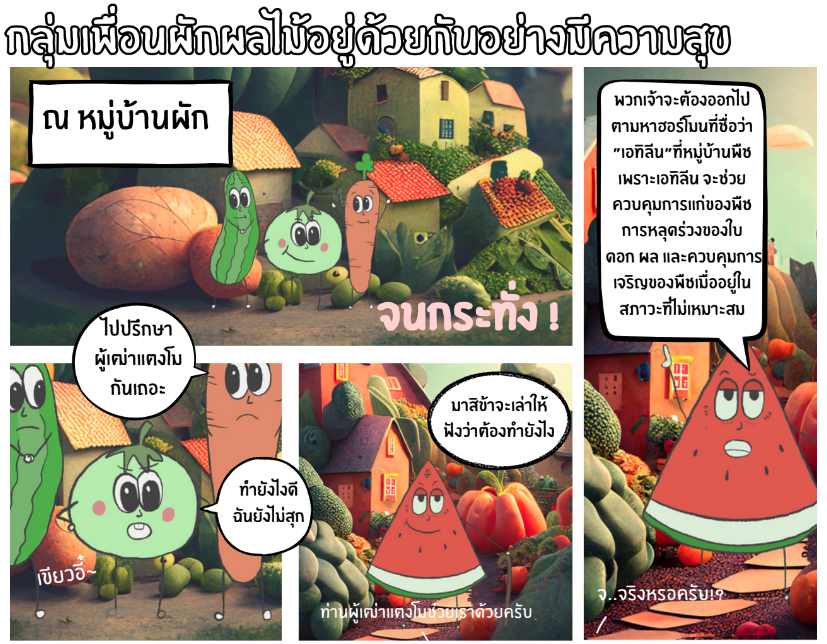การพัฒนาสมรรถนะการคิดสร้างสรรค์และนวัตกรรมของผู้เรียนชั้นมัธยมศึกษาปีที่ 4 โดยการสร้างการ์ตูนช่อง เรื่อง ฮอร์โมนพืช
Main Article Content
Abstract
Atthapol Hommai, Santichai Anuworrachai and Pongprapan Pongsophon
รับบทความ: 28 พฤศจิกายน 2566; แก้ไขบทความ: 2 กรกฎาคม 2567; ยอมรับตีพิมพ์: 7 กรกฎาคม 2567; ตีพิมพ์ออนไลน์: 6 ธันวาคม 2567
บทคัดย่อ
การวิจัยเชิงปฏิบัติการในชั้นเรียนครั้งนี้มีวัตถุประสงค์เพื่อพัฒนาสมรรถนะการคิดสร้างสรรค์และนวัตกรรม และศึกษาแนวปฏิบัติที่ดีในการพัฒนาสมรรถนะการคิดสร้างสรรค์และนวัตกรรมของของผู้เรียนชั้นมัธยมศึกษาปีที่ 4 โดยการจัดการเรียนรู้ด้วยการใช้โครงการเป็นฐาน ผ่านการสร้างการ์ตูนช่อง เรื่อง ฮอร์โมนพืช โดยการพัฒนาสมรรถนะการคิดสร้างสรรค์และนวัตกรรมนั้น วัดจาก 2 ส่วน คือ คะแนนพัฒนาการสัมพัทธ์ และร้อยละของคะแนนเมื่อเทียบกับคะแนนเต็มของแต่ละตัวชี้วัด ซึ่งสมรรถนะดังกล่าวมีทั้งหมด 8 ตัวชี้วัด โดยคะแนนพัฒนาการสัมพัทธ์ได้มาจากการใช้แบบวัดความคิดสร้างสรรค์และนวัตกรรม มาวิเคราะห์คะแนนพัฒนาการสัมพัทธ์ในแต่ละตัวชี้วัด ผลการวิจัยพบว่า ตัวชี้วัดที่ 7 การมองความล้มเหลวเป็นโอกาสในการเรียนรู้ คือ ตัวชี้วัดที่มีผู้เรียนที่มีพัฒนาการสัมพัทธ์ระดับสูงมากเป็นจำนวนมากที่สุด ขณะที่ตัวชี้วัดที่ 3 การพรรณนา วิเคราะห์ และประเมินความคิดของตนเพื่อการพัฒนาความคิดสร้างสรรค์ คือ ตัวชี้วัดที่มีผู้เรียนที่มีพัฒนาการสัมพัทธ์ทางบวกเป็นจำนวนมากที่สุด ในส่วนของร้อยละของคะแนนเมื่อเทียบกับคะแนนเต็มของแต่ละตัวชี้วัด ซึ่งได้มาจากการเก็บสะสมคะแนนจากการสังเกตพฤติกรรมและตรวจสอบชิ้นงานของผู้เรียนที่แสดงถึงแต่ละตัวชี้วัดไว้ โดยใช้เครื่องมือการวิจัย 4 ชนิด พบว่า ตัวชี้วัดที่ผู้เรียนมีคะแนนสูงที่สุด คือ ตัวชี้วัดที่ 8 การนำความคิดสร้างสรรค์มาสร้างนวัตกรรมที่เป็นรูปธรรมและมีประโยชน์ สำหรับการศึกษาแนวปฏิบัติที่ดีนั้น เก็บเครื่องมือโดยใช้บันทึกหลังสอน และบันทึกการนิเทศ แล้วนำมาสังเคราะห์ พบแนวปฏิบัติที่ดี 2 ประการ ได้แก่ 1) ครูควรให้อิสระทางความคิดแก่ผู้เรียนเพื่อให้ผู้เรียนได้พัฒนาความคิดสร้างสรรค์ และ 2) การเพิ่มกิจกรรมที่ให้ผู้เรียนได้แลกเปลี่ยนกันภายในกลุ่มทำให้ผู้เรียนกล้าที่จะนำเสนอและให้ข้อเสนอแนะที่มีคุณภาพมากยิ่งขึ้น
คำสำคัญ: สมรรถนะการคิดสร้างสรรค์และนวัตกรรม, การจัดการเรียนรู้ด้วยการใช้โครงการเป็นฐาน, การ์ตูนช่อง
Abstract
The objectives of this classroom action research were to develop creativity and innovation competency and identify the best practices for enhancing creativity and innovation competency in grade 10 students using project–based learning through creating plant hormone comics. The development of creativity and innovation competency was assessed through two measures: relative development scores and the percentage of the score compared to the full score for each of the eight indicators of this competency. The relative development score was derived from a creativity and innovation competency test for each indicator. The results indicated that Indicator 7, “viewing failure as a learning opportunity,” has the highest number of students achieving very high relative development scores. Indicator 3, “describing, analyzing and evaluating one’s own ideas for developing creativity,” shows the highest number of students with positive relative development scores. The percentage scores relative to the full score for each indicator were obtained by observing behavior and evaluating student work that demonstrated the characteristics of each indicator using five research tools. The results revealed that Indicator 8, “using creativity to create concrete and useful innovations,” had the highest percentage score. The best practices were synthesized from lesson plans and feedback notes. The findings suggested two best practices: 1) Teachers should encourage students to think freely to foster creativity development, and 2) Enhancing communication within group activities to increase students’ confidence in presenting and providing quality suggestions.
Keywords: Creativity and innovation competency, Project–based learning, Comics
Downloads
Article Details

This work is licensed under a Creative Commons Attribution-NonCommercial 4.0 International License.
References
Anderson, L. W., and Krathwohl, D. R. (Eds.). (2001). A Taxonomy for Learning, Teaching, and Assessing: A Revision of Bloom’s Taxonomy of Educational Objectives. New York: Longman.
Badriah. (2017). The use of comics to allow creativity and promote higher order thinking skills. Journal of English Language Learning 1(1): 9–16.
Battelle for Kids (2019). Framework for 21st Century Learning Definitions. Retrieved from https://static.battelleforkids.org/documents/p21/P21_Framework_DefinitionsBFK.pdf, November 4, 2022.
Buck Institute for Education. (2019). Creativity & Innovation Rubric for PBL: for grades 6–12; CCSS ELA. Retrieved from https://cstl.org/cleantech/wp-content/uplo ads/2021/02/PBL-Innovation-Rubric-with-Sustainability-Section.pdf, November 4, 2022.
Catalina Foothills School District. (2019). Creativity and Innovation Rubric Grades 9–12. Retrieved from https://cleanfounda tion.ca/wp-content/uploads/2020/01/Inno vation-Rubric.pdf, November 22, 2023.
Dublin City Council. (2020). The Benefits of Comic Books. Retrieved from https://www.dublincity.ie/library/blog/benefits-comic-books, November 6, 2022.
Guilford, J. P. (1950). Creativity. American Psychologist 5(9): 444–454.
Guilford, J. P. (1967). Creativity: Yesterday, today, and tomorrow. The Journal of Creative Behavior 1(1): 3–14.
Holley, M. (2015). Project–Based Learning: Fostering Creativity and Innovation in Students. Retrieved from https://www.methodschools.org/blog/project-based-learn ing-fostering-creativity-and-innovation-in-students, March 5, 2566.
Hosler, J., and Boomer, K. B. (2011). Are comic books an effective way to engage non majors in learning and appreciating science? CBE Life Sciences Education 10: 309–317.
Hurlock, E. B. (1972). Child Development. 5th ed. New York: McGraw–Hill.
Junhorm, C. (2018). How Can I Develop the Creativity and Innovation skills of 21st Centuries of Grade 9th through STEM Education. In Ugsonkid S., Boonchuaythanasit K., Sumalee, S., and Chuntra C. (Eds.), The Story of Classroom Research (pp. 98–111). Bangkok: Vistra Interprint. (in Thai)
Kanjanawasee, S. (2009). Classic Test Theory. 6th ed. Bangkok: Chulalongkorn University. (in Thai)
Kemmis, S., and McTaggart, R. (1988). The Action Research Planner. 3rd ed. Geelong: Deakin University.
Miller, A. (2018). Time Management with PBLB. Retrieved from https://www.edutopia.org/article/time-management-pbl/, November 22, 2023.
Nualchan, W. (1996). Effect of Product Addition in Creative Art Activity on Creative Thinking of Young Children. Master of Education in Early Childhood Education. Bangkok: Srinakarinwirot University. (in Thai)
Office of the Basic Education Commission. (2021). High Order Thinking Competency. Retrieved from https://cbethailand.com/หลักสูตร-2/กรอบหลักสูตร/สมรรถนะหลัก-6-ประการ/สมรรถนะการคิดขั้นสูง/, November 4, 2022. (in Thai)
Office of the National Economic and Social Development Board. (2018). National Strategy 2018–2037 (Summary). Retrieved from https://www.nesdc.go.th/down load/document/SAC/NS_SumPlanOct2018.pdf, November 3, 2022. (in Thai)
Office of the National Economic and Social Development Council. (2022). The Thirteenth National Economic and Social Development Plan (2023–2027). Retrieved from https://www.nesdc.go.th/article _attach/article_file_20230615134223.pdf, November 3, 2022. (in Thai)
Onarheim, B. (2012). Creativity from constraints in engineering design: Lessons learned at coloplast. Journal of Engineering Design 23(4): 323–336.
Ouppaphan, K. (2021). Torrance’s Future Problem Solving Instructional Model to enhance creativity in Mahidol Wittayanusorn School. Retrieved from http://backoffice.thaiedresearch.org/uploads/paper/43acbe3d8da5cf5b06206e09, November 3, 2022. (in Thai)
Panich, W. (2012). The Way to Create Learning for Students in the 21st Century. Bangkok: Sodsri–Saritwong Foundation. (in Thai)
Pimthong, P. (2021). STEM Education. 2nd ed. Bangkok: Vista Inter Print. (in Thai)
Silva, A., Santos, G., and Bispo, A. (2017). The comics as teaching strategy in learning of student in an undergraduate management program. Revista de Administração Mackenzie 18(1): 40–65.
Wijayati, N., Sumarni, W., and Supanti, S. (2019). Improving student creative thinking skills through project based learning. KnE Social Sciences 3(18): 408–421.
